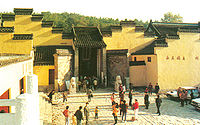Views
m |
m |
||
| Line 14: | Line 14: | ||
==History== | ==History== | ||
| - | This is the largest temple on Bǎohuá Mountain [[寶華山]] and the two are often treated synonymously. The temple was founded during the Liáng 梁 Dynasty, in 502 (Tiānjiān 天堅 1). It received its current name from Emperor Shénzōng 神宗 of the Míng 明 in 1605 (Wànlì 萬曆 33). From the Míng onward, this temple has maintained the largest ordination platform in China.<ref> This [http://www.longchangsi.com/Article/lcjj/200712/Article_20071202130748.html page] on the Temple's website claims that since that dynasty, 70% of all Chinese monastics have been ordained here.</ref> For example, ordinations held in [[1900]] (Guāngxù 光緒 26) attracted over 1,200 ordinands. Throughout much of the 20th century, this temple was the site of the largest and most frequent monastic ordination. These ordinations were carried out at least as late as 1957. It has once again assumed its status as the primary ordination center, having been officially re-opened in April, 1983. During the early 20th century as well, training and ordination at this temple were felt to be the most rigorous, and accorded the monk was ordained here | + | This is the largest temple on Bǎohuá Mountain [[寶華山]] and the two are often treated synonymously. The temple was founded during the Liáng 梁 Dynasty, in 502 (Tiānjiān 天堅 1). It received its current name from Emperor Shénzōng 神宗 of the Míng 明 in 1605 (Wànlì 萬曆 33). From the Míng onward, this temple has maintained the largest ordination platform in China.<ref> This [http://www.longchangsi.com/Article/lcjj/200712/Article_20071202130748.html page] on the Temple's website claims that since that dynasty, 70% of all Chinese monastics have been ordained here.</ref> For example, ordinations held in [[1900]] (Guāngxù 光緒 26) attracted over 1,200 ordinands. Throughout much of the 20th century, this temple was the site of the largest and most frequent monastic ordination. These ordinations were carried out at least as late as 1957. It has once again assumed its status as the primary ordination center, having been officially re-opened in April, 1983. During the early 20th century as well, training and ordination at this temple were felt to be the most rigorous, and accorded the monk who was ordained here a certain status among Chinese Buddhists.<ref>The ordination process as it was carried out in the 1940s is outlined in Chen-hua, ''In Search of the Dharma: Memoirs of a Modern Chinese Pilgrim'' (Albany: SUNY Press, 1992).</ref> |
==Personnel== | ==Personnel== | ||
Revision as of 00:34, 23 July 2010
Lóngchāng sì 隆昌寺
|
|
|
|
Lóngchāng sì 隆昌寺 is perhaps the most important center for both ordination and Vinaya 律 training in China.
Contents |
History
This is the largest temple on Bǎohuá Mountain 寶華山 and the two are often treated synonymously. The temple was founded during the Liáng 梁 Dynasty, in 502 (Tiānjiān 天堅 1). It received its current name from Emperor Shénzōng 神宗 of the Míng 明 in 1605 (Wànlì 萬曆 33). From the Míng onward, this temple has maintained the largest ordination platform in China.[1] For example, ordinations held in 1900 (Guāngxù 光緒 26) attracted over 1,200 ordinands. Throughout much of the 20th century, this temple was the site of the largest and most frequent monastic ordination. These ordinations were carried out at least as late as 1957. It has once again assumed its status as the primary ordination center, having been officially re-opened in April, 1983. During the early 20th century as well, training and ordination at this temple were felt to be the most rigorous, and accorded the monk who was ordained here a certain status among Chinese Buddhists.[2]
Personnel
Important Abbots
Notable Residents and Ordinands
- The Living Buddha of Jīnshān 金山活佛 ord. ??
- Láiguǒ 來果 and Rénshān 仁山 ord. 1905
- Chángxǐng 常惺 ord. mid 1910s
- Fǎzūn 法尊 studied the Vinaya here around 1921
- Dàyú 大愚 ord. 1923
- Shì Dōngchū 釋東初 ord. 1929
- Jùzàn 巨贊 ord. 1931
- Cízhōu 慈舟 ord. 1934
Temple Institution
Important Buildings or Artifacts
Associated Organizations and Groups
- Bǎohuá Mountain Vinaya Seminary 寶華山律學院
Notes
- ↑ This page on the Temple's website claims that since that dynasty, 70% of all Chinese monastics have been ordained here.
- ↑ The ordination process as it was carried out in the 1940s is outlined in Chen-hua, In Search of the Dharma: Memoirs of a Modern Chinese Pilgrim (Albany: SUNY Press, 1992).
References
- Welch, Holmes. The Buddhist Revival in China. Cambridge: Harvard University Press, 1968. Pp. 103-107.
- 寶華山志 (Shì Shèngxíng 釋聖性, Qiánlóng 乾隆 1785-1795) from Dharma Drum's Temple Gazetteer Project.
- Official Chinese website for the temple.
